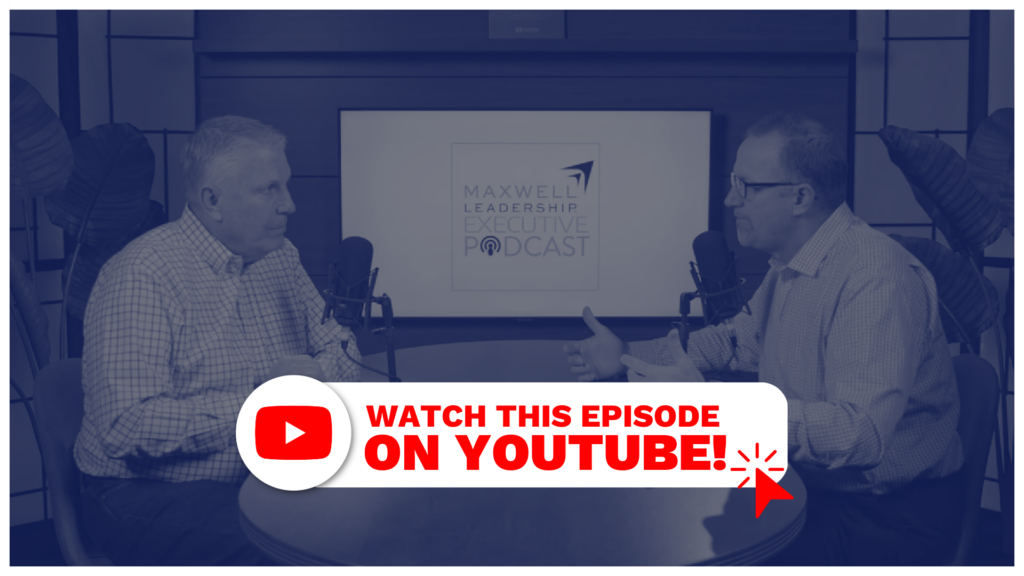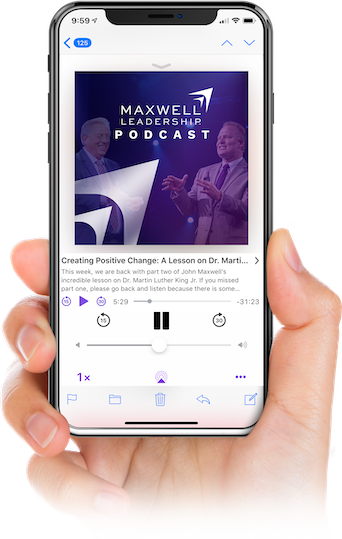Executive Podcast #350: Strategies for Leading a Remote Workforce

In this episode, Chris Goede and Perry Holley discuss strategies for leading a remote workforce effectively. They share insightful data from a recent Gallup report, which reveals the engagement levels and overall well-being of remote, hybrid, and on-site employees. Chris and Perry explore the factors that contribute to the mental and emotional challenges faced by remote workers, such as physical distance, excessive autonomy, and technology frustrations. They also provide practical tips for leaders to enhance the experience and engagement of their remote teams, including encouraging frequent and varied communication, exhibiting inclusive leadership behaviors, promoting cross-team collaboration, and supporting work-life balance.
References:
Become a Maxwell Leadership Certified Team Member!
Get the Maxwell Leadership Growth Plan!
Download our Learner Guide for this podcast!
Perry Holley:
Welcome to the Maxwell Leadership Executive Podcast where our goal is to help you increase your reputation as a leader, increase your ability to influence others, and increase your ability to fully engage your team to deliver remarkable results. Hi, I’m Perry, Holly a. Maxwell Leadership facilitator and coach.
Chris Goede:
And I’m Chris Goede, executive vice president with Maxwell Leadership. Welcome and thank you for joining us today. We want to give you a new URL to go to. If you want to leave a comment, a question for us. Maybe you want to download the learner guide, go to MaxwellLeadership.com/ExecutivePodcast. We have finally arrived. Now it’s our own. Yes, this is unbelievable.
Chris Goede:
So but we’d love for you to go there and there you can learn everything that you need to know. We would love to serve you in any way.
Perry Holley:
Recliners in here next.
Chris Goede:
I think we’re headed that way. We’re headed that way. We’re only at podcast 350 today, by the way. So when we get to 700, they said that we’d get some recliners. You guys might not be still listening, but Perry and I will be snoring in a recliner by then. But I want to encourage you to go there. Thank you again for listening. Reviewing.
Chris Goede:
We so love doing this for you guys. Today’s topic is strategies for leading a remote workforce. This is, no doubt about it, a challenge. It’s a conversation that happens often. Leaders are talking about this and they’re trying to get their head around how do we drive an engaged community and a healthy community when we have the dynamics of working from home. Some companies have hybrids, some aren’t allowing it whatsoever. And so the dynamics of that are just fascinating. It’s interesting because Perry and I both saw a Gallup report that we want to share some data with you.
Chris Goede:
And if you haven’t seen this, we encourage you to kind of look it up because it was really eye opening for us. Now, this is a global study, so hear me say that it’s a global study and we’re going to include some of this in the the Show Notes Learner Guide so you can get there that at that website. So from this report, let me read you some data here really quick. This is globally, fully remote workers are the most likely to be engaged at work. 31% compared with a hybrid back and forth, 23% engaged on site, non remote. We came back to the office, you don’t have an option. They’re also only 23% engaged. And then finally, if they’re on site, but they have the remote capability was 19%.
Chris Goede:
So this is a worldwide look at how we’re doing work and how we’re engaging inside our work, but also the impact which we’re going to talk in just a minute that it’s had on our personal lives.
Perry Holley:
Well, they say in the part of the report was so interesting about how it affects their wellness or how it affects their well being and their engagement factor, but that although they said that the remote workers report higher engagement, they’re less likely to be thriving in their lives overall. And so it said the fully remote person showed 36% of the thriving scale and that was only 1 lower than them. On that was the fully on site, but non remote 30%. The hybrid and the on site with remote capable were at 42%. So all of it’s really low.
Chris Goede:
Anyway, I was going to say, yeah, all of it like you talked about, is way too low.
Perry Holley:
They also stated in the report that fully remote employees are also more likely to experience things like emotions like anger, sadness, loneliness than any of the other workers there. So just very interesting if you think, and like you said, it’s a conversation that’s going on in most companies that we work with and most of the executives we partner with, they’re having some debate or discussion around how to. What 2020 and Covid taught us was that we were forced to work at home. And then coming back, you know, one of our culture pieces here is that we thrive on our culture, on being together, collaboration. And so it’s, it’s really an interesting conversation.
Chris Goede:
It’s really interesting to look at that and to understand the tie between the engagement level and these options. And then they’re thriving kind of in their personal life. And you look at that and again, to Perry’s point, it’s all way too low and it’s just hard to make sense of. So what we want to do is dig in a little bit today and say, what are some things that are driving those that are in the remote space? Right. That’s what we’re talking about today is leading a remote workforce. The, the emotional, the mental side of it, the taxing, the draining. It’s like work’s always on versus where, you know, you go into an office and you check in and check out.
Perry Holley:
Right.
Chris Goede:
For the most part. I mean, some of us don’t ever do that. Right. Mentally, you’re into it, but it’s different every moving location. Everybody except for Perry and I, because we’re coming up with this content for you and our podcast or even In a hybrid arrange of. Of what that looks like. So a couple of things for you really quick right here that they mention is the, The. The physical distance of doing life with people can create a mental distance.
Chris Goede:
And so if we’re not in the office, if there’s not camaraderie, you know, we’re meant to do life with people, the friendships, the team lunches, all of that. Like, if you’re not a part of that, you almost become even further from that. Like, you feel like you’re missing out or not a part of that culture and of that tribe, no matter how hard you try to do it virtually. Autonomy can be stressful.
Perry Holley:
Right.
Chris Goede:
I love this. Where they want. We all want more autonomy.
Perry Holley:
Leave me alone.
Chris Goede:
Let me go. I want to be able to go and get my dry cleaning, you know, while I’m on a zoom call in my, you know, all we want, all of that. But what. What they’re finding is that it can be stressful and it can be too much on them to have all that autonomy, and it would not, you know, be healthy for the employee. Then the final one is the technology can frustrate. And I can speak to this right here.
Perry Holley:
Did you ever join that call?
Chris Goede:
Yes. No. And I still to this day. Okay. Perry and I. He’s referring To a call 24 hours ago, important call that I set up, that all of a sudden, that all of a sudden Perry was leading and Perry probably did a better job than I did. I’m texting Perry, just can you and I still have the same issue. I have not yet solved my computer issue, and I’m in the office.
Chris Goede:
And so this is so funny because when you are at home and technology is an issue, man, it can be so frustrating and you don’t feel like the IT people see you. And as Perry and I talk about, we want to feel seen, valued, and heard.
Perry Holley:
So I’m sensing some anger.
Chris Goede:
And right now I am in the office and I am still not thriving personally because. And I’m not very engaged because of my laptop issue. But. But we’ve all been there where you’re at home and you got no answers, technology wise. And so at least when you’re in the office, there may be some teams there to help support you. So three reasons right there on why the remote side can be mentally and emotionally taxing. That driving down some of those numbers.
Perry Holley:
Yeah. And so let’s talk about some practical things. Maybe as a leader, you could do to enhance the experience and the wellness and the engagement of the team. Some of these come from the Gallup studies and suggestions they made and some come from some ideas that we’ve seen. First one was just to encourage frequent and varied communication. I like to add the word varied and I want to ask you about what frequent means. But you know, video and voice, not just text based types of tools, regular check ins, regular team meetings, project updates, helping team members feel like they’re seen. That’s a great word to use and that feel like they’re included, kind of reducing any feelings of isolation.
Perry Holley:
You don’t know where I am, you don’t know what I’m doing. So I think this idea, I wondered how. Because you, you lead a team that is 100% remote capable, but half are probably in the office and half are remote and. But everybody can go. I see, you know, some go half a day off and home and a full day once a week, that type thing. So you’ve got some varied in there. But is it too much communication? Can, can you. Is frequent a lot? What do you think about that?
Chris Goede:
You said they take a half day off. I just want to clarify. They work remote half day. Sorry Mark, in case you’re listening, great question, right. So here’s the challenge that we face here in our world because we’re in the service industry and we’re serving clients and we’re out in the field. Not only do I deal with as a leader, many of you do as well with the remote option for our team, but then I am on the road traveling and. Or they are and that even when they were had the remote capable, but they’re in the office, I may not see them. And so you got all these type of dynamics.
Chris Goede:
So how do you do that? What I’ve heard from my team, some more than others, that they just want to hear from my voice more often, right. They want to know, hey, what, just give me an update what’s going on. Like it could be little stuff about the business, but to know that I’m engaged, that I’m there and I’m not just kind of, I’ve quietly quit on them. Right. Which is not the case. But sometimes our mind can allow that to happen. Another thing I’ve learned too, and this is from my wife Sarah, which she has beat this in my head, probably because I’m bad at it, which is when there is a lot of silence, when there’s not frequent conversation, no matter what’s going on, we fill in the story in our head with the most negative version of that story, whatever it is. Chris doesn’t think I’m producing enough or I missed this deadline.
Chris Goede:
Oh my gosh. And that’s not what I must be mad, but it must be mad I haven’t heard from him. And that’s been really something that I’ve had to learn and to get better at. And so also, in addition to what I like to say, quick touch points multiple times a week, it’s hard for me to do that and I need to do a better job of doing that. But it’s just being intentional about certain touch points. And I like how you said variable ways of doing it because I find myself right now zoomed out. Okay. Like, I’m done with zoom.
Chris Goede:
And I’d rather just pick up the phone and just call and just check in, say, you know, man, hey, Nikki, how’s it going? One that’s working out on the West Coast. Right. And so I can check on her a little bit later in the day versus, you know, checking on her first thing in the morning when I get in office. You and I are early risers, so it’s not good to call somebody in California when I’m in the office at 5:30 or 6:00. So, yeah, so I think there’s a couple different things, but the goal there is. And we talk a lot about this in the course that you helped us create around inclusive leadership. How do we get to a place that everybody feels like they belong? We struggle with this on, on some of the our coaches and our facilitators, and I know we do. They’re out getting after it every day and they’re with our clients coaching and facilitating.
Chris Goede:
There’s just not a lot of touch points coming from Maxwell Leadership’s corporate office. And they, they feel like they’re not seen. They feel like they’re. And so how do we do a better job of that? I think we can always make sure that they feel like they belong in that and they’re connected to our team.
Maxwell Leadership Certified Team:
Hey, podcast listeners, many of you listening right now would probably love the autonomy the that comes with owning your own business or becoming a coach that helps other businesses succeed. Well, we have a phenomenal strategy where you are 100% in control of your own business, earning income on your own terms, and have access to the people, tools and resources you need to build a thriving leadership development business. When you become a Maxwell Leadership Certified team member, you join a global community of entrepreneurs led by our expert team of mentors and faculty, including John C. Maxwell. You’ll also get one of the top leadership certifications in the world next to your name, giving you the boost you need to get started. Visit us online at MaxwellLeadership.com/JoinTheTeam to find out more.
Chris Goede:
So the second one here, talking about inclusive leaders. How do we. How do we become and act like an inclusive leader when it comes to this? And so how can we exhibit those things and those cues to our remote workforce that everyone is involved in what’s going on inside our team?
Perry Holley:
Yeah, this is used. No leader ever that I know of came to work and said, how can I exclude my team and make them feel isolated today? We don’t. We’re just like you said, you’re busy. You’re going 100 miles an hour. Going 100 miles an hour. What do I do? So. And that belonging piece of inclusive is so huge. It’s a natural human.
Perry Holley:
Everybody has it. It’s part of your natural makeup. We want to belong. And belonging means I can be me fitting in. I need to be like you want me to be, but belonging is I can be myself. And so, you know, a couple of strategies we teach in the course around giving. Giving power, giving power away, Giving. Empowering people to do their work, letting them take ownership of the work, checking in with them, letting them know that you.
Perry Holley:
You believe in them and that they. They. They own this for you. And it really gives me that sense of I belong here. Listening and responding to feedback from them, to, you know, create this environment where it’s. It’s psychologically safe to, to talk with you, to. To share things with you, to share my frustrations. Does.
Perry Holley:
Does somebody who’s feeling anger or. Or bad emotions, isolation, being at home, is it okay to tell you that? Boss, can you get on the phone and say, man, I’m really feeling left out. I’m really feeling that you don’t know I’m here. The facilitators and coaches are all. They’re slopping a suitcase, they’re catching a plane. You know, this routine. We all do it, but you feel alone out there to do that. And then I think, helping everyone know how their work connects to what we do.
Perry Holley:
You do a really nice job of this about telling. From the facilitator to the administrative team, to the marketing team, to the sales team, letting them know how what they do contributes and connects. Why we need you doing, how important what you do is. And so that sense of ownership and ability to do my work.
Chris Goede:
Yeah.
Perry Holley:
And I. Knowing that it’s important, all of a sudden I start to feel like I belong here, even though I may not see you every day I know you know I’m here.
Chris Goede:
Yeah. And this is hard to do. I want to comment off of one of the things you said about even just making sure everybody feels like they belong. Sometimes you got to move meetings around when you have people in different time zones. We have one of our incredible facilitators and coaches who is an avid listener and gives us ideas all the time and feedback which we love. He’s over in London and so it’s thinking about when do I set up my calls, you know, with him and his time zone. He’s always more than willing to be on a call at 8, 9, 10pm at night. That’s not what we want.
Chris Goede:
That’s not thriving personally. And so how do we try to adjust that? Or even the example, you know, Nikki on our team is lives in California and so we changed our team meetings from 10am Eastern to now it’s 1pm Eastern. The reason, so that she doesn’t have to be up and ready to go. Now most of the people on the west coast are by 7am it’s just how they’ve done life. But we moved it later in the day. Are there things like that that you can be. That you can do that makes them feel inclusive part of the team?
Perry Holley:
You’re not making me always been to your.
Chris Goede:
Yeah, correct. Because I.
Perry Holley:
In the office we always.
Chris Goede:
Yeah, that’s right. Number three, encourage cross team collaboration. And so love this idea which is how do we again rotate team meetings to accommodate different time zones that we talked about? That’s great. But also how do we then get our team to be in other teams meetings and to cross functionally understand what’s going on in the business to be able to do that. Not only are they going to learn something about the business but they’re actually going to kind of feel aligned to the broader part of what the company’s doing. I’ll give you an example of this. We have a. On our non profit side we do a lot of work with school districts and superintendents and Tim Elmore’s content and we’re, you know, we’re taking stuff in and we’re helping really develop some character content in schools.
Chris Goede:
And they have a sales team over there and so periodically now those are, they’re all, they’re all remote. They’re ones down in, you know, South Florida, one’s out in the Midwest. And and so we are actually now saying, hey, come join into our meeting. Like watch how we’re talking about our numbers and sales and what are we doing. And so I think just thinking about that and the cross team collaboration as a very small example of what you could do because when they are remote there’s no commute. Right. And there’s the opportunity for them to be a part of meetings more than they would be if they were in person.
Perry Holley:
I love that. And then number four would be. We were really good at this during the COVID years promoting social interaction, not just team building. So I remember in Covid there would be the, the coordinated team lunch or the happy hour or the somebody you know got everybody together to, to talk about fun stuff and it was not work related but we did that easily when we couldn’t come to the office. Now we’re in the office, we going a little fast for that. But setting up dedicated time or dedicated channels to have casual conversations. So the idea is promoting social interaction which helps me fulfill my I belong here, I’m connected to people. I saw one group implemented like a buddy system where almost like a mentorship program where they let two people connect outside of their work activity.
Perry Holley:
So regular check ins, regular how you doings? Regular. What do you need just from somebody? Not your boss but kind of assigned co mentoring process with people. So I love the idea but can you other. It has to be very intentional though. How are we going to do to get this social interaction and team bonding that’s not necessarily work or project related.
Chris Goede:
And what I would encourage you here because most of you listening to this are probably like oh, we’re trying all these things and this is a topic that’s been talked about. We, we are aware of that because we hear it with all the clients that we work with and everybody’s still working through some best practices. And so there’s no right or wrong. These are just some things that we’ve seen kind of stay the test of time of, of what we tried. One of the things about, I want to comment off yours is don’t just do it to do it. Like that’s the worst is when we’re talking about doing the interaction or the team bonding and there’s no purpose behind it. It’s like, oh, we’re just going to keep doing this because we want to make sure we’re allowing time for our team to be able to collaborate. That’s just everybody can feel it and everybody knows it.
Chris Goede:
So the intentionality behind what it is and even if it’s not as frequent but when it happens there’s more engagement around it. I think the better.
Perry Holley:
Well, you know you do on our weekly Team call. You started the process of off right off the bat instead. And where some of us are on the zoom, some of us are in the room. And so we see, you know, about half and half. Half are on the screen, half are in the room. And it goes fast. But everyone. Until one thing from over the weekend.
Chris Goede:
We’re on Mondays. Yeah.
Perry Holley:
Yeah. So what. What was the best thing that happened over your weekend? Or what was one win from last week? Personally or professionally?
Chris Goede:
Yeah.
Perry Holley:
And you just. And we used to do both, but then it got to be a 40.
Chris Goede:
Minute and the team’s growing, so.
Perry Holley:
Yeah.
Chris Goede:
Yeah. Then it’s like the meeting’s over. Wait a minute. We haven’t even talked about anything.
Perry Holley:
Yeah. So now it’s gotten pretty quick. Just one thing and let us know what’s going on in your life. What did you. What did you do? And we hear all kinds of things with. With children and, you know, grandchildren and relatives and projects and. And it makes you just. You just know what.
Perry Holley:
Hey, I didn’t know you did that.
Chris Goede:
Okay.
Perry Holley:
You know.
Chris Goede:
Yeah. Love it. Do all kinds of things. Just get creative. But just make sure you’re intentional behind it. Yeah. Because that’s just a way that we do it here. Just to create engagement and to allow the team to connect in ways that maybe they didn’t know.
Chris Goede:
They may. Perry might have done something over the weekend that spurred somebody else to ask them a question. Because Perry loves to, you know, smoking barbecue and grill outside. He’s got all kinds of. And somebody else is like, I’m cooking this weekend. I need to call Perry. Right. Just things like that that go above and beyond.
Chris Goede:
Okay, the last one and then. And I’ll wrap up. This is something that. It’s number five. Perry, I don’t even know if you can comment to this because of your work day and. And how old school. There was no work life balance back in. In your day.
Chris Goede:
Right. And so we’re like, what is this work life balance comment? And so the number five is how do we support that? A work life balance and well being of our team. The reason we’re talking about this is because of the statistics that we’re seeing from Gallup and thriving, but also the remote workforce. Often they’re rolling right out of bed, they’re sitting right in front of the computer, and then their family’s like, hey, you going to come have dinner with us? And it’s seven o’ clock and they’re rolling right back out. There’s no. In the field where we were going different Clients having lunch with people, taking breaks, doing these different things. Now, that may not be the case for all of us that are working remote. Matter of fact, some of you may be doing a little bit too much of breaking and Laundromat and lunch and meetings and all of those things.
Chris Goede:
But here’s what I would say is that we’ve got to make sure we are doing our best to be aware of our team burning out from those that are sitting in the remote world. I know you’re working really closely with Valerie Burton and we’re going to be rolling out a content piece here soon on resilience. And part of that we’re coming to the table saying, here’s how you need to be looking at and aware of your team and where are they at in that kind of resilience? Part of it. I also want to mention this. Our, our nonprofit that I talked about just a few minutes ago, they had an interesting thing where one day during the week they had no meetings. And if you wanted to schedule meetings inside the office, outside the office, whatever, let’s just say you did it on Monday, Tuesday, Thursday, Friday, Wednesday is a no meeting zone. And it was so that people can really get to work and do their focused work. And so I saw that work and that was interesting in order to make sure people felt like coming out of that no meeting.
Chris Goede:
Because I don’t know about you, I’m in way too many meetings. And then when I’m at the end of the day and I was in meetings, I get anything done and then I still got a list of stuff that we want to, that we want to do. And so this gave them that out. Right. The, the wellness of people feeling like they knock some things out during that week. Just as an idea. And then my last comment, and I think you put this in here for me, and I don’t like to talk about it, is that leaders you need to model the fact that you don’t need to always be on.
Perry Holley:
Yeah.
Chris Goede:
So whether you use tools in your outlook to have emails being held until Monday morning or you’re doing something or at least if you have to be seen getting after it, where no work life balance, make sure that the team you verbally say this is not expected of you. Even when you say that though, they’re still going to expect a response from you. So man, really work hard to model the behavior of what we’re expecting in this support the work life balance area that we’re talking about and it will create a better environment.
Perry Holley:
You do a good job on that. You do a good job with that.
Chris Goede:
Yeah. Yes, to some extent. Yeah. Well, let me wrap this up. I think this is an issue, and I want to go back. Here’s what I want to do. I want to go back to these statistics, because this is what keeps Perry and I up at night, both personally and professionally. I mean, the thriving part, the numbers are.
Chris Goede:
Are well below, you know, 50%. And the engagement part of all situations, people working is even less than that. Now, we care about people more than we do the engagement, but we care about both. And so in this situation, I’m just saying, hey, you got to be aware of this data, and look what’s going on to your. Look what’s going on with your team. And this is, again, what keeps us up at night. This is what keeps us going every day. We want to see these engagement levels start to increase by helping leaders understand that.
Chris Goede:
I think they begin to increase when you begin thinking about the other statistics that Perry shared with you around thriving and how do I help them thrive, not only in the workforce, but in their home life. And when that happens, I love people that are like, I’m a different person at work than I am at home. No, you’re not. No, you’re not. So what are we doing as leaders to help them thrive, even if they’re working at home and they’re fully remote? And when we do that with the right motive, it’s not the reason, the motives pure, then your engagement scores are going to increase. So be aware of this data because it’s real.
Perry Holley:
It is. And it’s really a leader situation. Leaders, everything rises and falls right on leadership. Well, just as a reminder, if you’d like to get the learner guide for this episode or Learn about our 5 levels of leadership or other offerings, you may do that at MaxwellLeadership.com/ExecutivePodcast. You may also leave us a question or a comment. We love hearing from you. Very grateful you’d spend this time with us today. That’s all from the Maxwell Leadership Executive Podcast.
Transcript created by Castmagic.
Maxwell Leadership delivers corporate training that strengthens executive leaders, aligns teams, and transforms culture. Discover how our proven frameworks equip your organization to lead with clarity and impact.
To be a Successful Leader, You Need Feedback on Your Leadership.
We’re excited to announce our new and improved Organizational Effectiveness Survey (OES). The OES gathers feedback from employees to give leaders and management the knowledge and action plans needed to develop a more effective and productive work environment. Our new version measures 4 areas of your business: Leadership, People, Strategy, and Performance.













Be the first to comment on "Executive Podcast #350: Strategies for Leading a Remote Workforce"